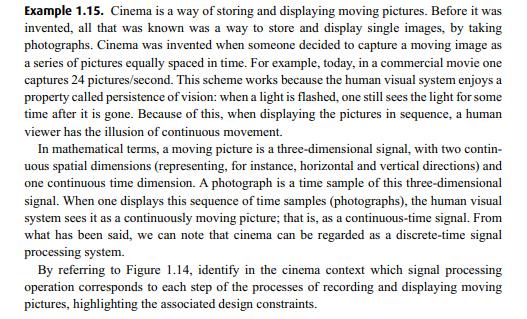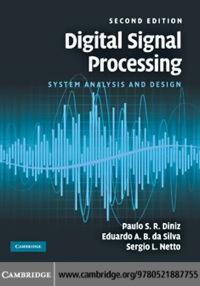Question:
As seen in Example 1.15, cinema is a three-dimensional spatio-temporal signal that is sampled in time. In modern cinema, the sampling frequency in order to avoid aliasing is \(\Omega_{\mathrm{s}}=24 \mathrm{~Hz}\). However, the persistence of vision is equivalent to a time filter with a bandwidth of \(\Omega_{\mathrm{LP}}=48 \mathrm{~Hz}\). In order to avoid flickering and at the same time avoiding doubling the number of samples, in cinema one repeats each picture twice. For a given

point on the screen, this is equivalent to having a train of impulses \[g_{\mathrm{i}}(t)=\sum_{n=-\infty}^{\infty} g(n) \delta(t-n T)+\sum_{n=-\infty}^{\infty} g(n) \delta\left(t-n T-\frac{T}{2}\right)\]
where \(T=1 / 24 \mathrm{~Hz}\). Show that with the above scheme the persistence of vision allows the human visual system to have the impression of continuous movement.
Transcribed Image Text:
Example 1.15. Cinema is a way of storing and displaying moving pictures. Before it was invented, all that was known was a way to store and display single images, by taking photographs. Cinema was invented when someone decided to capture a moving image as a series of pictures equally spaced in time. For example, today, in a commercial movie one captures 24 pictures/second. This scheme works because the human visual system enjoys a property called persistence of vision: when a light is flashed, one still sees the light for some time after it is gone. Because of this, when displaying the pictures in sequence, a human viewer has the illusion of continuous movement. In mathematical terms, a moving picture is a three-dimensional signal, with two contin- uous spatial dimensions (representing, for instance, horizontal and vertical directions) and one continuous time dimension. A photograph is a time sample of this three-dimensional signal. When one displays this sequence of time samples (photographs), the human visual system sees it as a continuously moving picture; that is, as a continuous-time signal. From what has been said, we can note that cinema can be regarded as a discrete-time signal processing system. By referring to Figure 1.14, identify in the cinema context which signal processing operation corresponds to each step of the processes of recording and displaying moving pictures, highlighting the associated design constraints.







